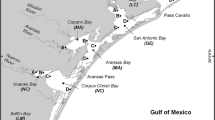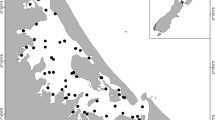Abstract
In coastal marine ecosystems, the environmental stress model (ESM) predicts that the central measures (i.e., the mean or median) of species richness are highest at intermediate stresses (e.g., intermediate levels of light and wave exposure). It is now appropriate to examine ESM over larger spatial scales beyond a single shoreline, using a continuous stress scale, and non-central measures of species richness. The relationship between marine macrophyte richness and a continuous stress gradient (i.e., hydrodynamic stress) from 210 sites in the Northern Ryukyu Archipelago were examined. Expectile regression splines were used to determine how non-central measures of richness vary with stress. Species richness peaked at intermediate stresses and this feature was strongest at the higher expectiles (i.e., in the upper tails of the distribution of species richness). The fitted expectile regressions converged at the highest and lowest stress, and were widely spaced at intermediate values. This suggests that environmental stress, as determined, is the process that controls species richness at low and high stress. A provisional analysis assuming a Gumbel distribution to model the extreme values of species richness mirrored the patterns elucidated by the expectile regression. Expectile regression and extreme value approaches may provide a means of predicting the occurrence of species richness maxima at the regional scale.



Similar content being viewed by others
References
Austin M (2007) Species distribution models and ecological theory: a critical assessment and some possible new approaches. Ecol Model 200:1–19
Bruno JF, Stachowicz JJ, Bertness MD (2003) Inclusion of facilitation into ecological theory. Trends Ecol Evol 18:119–125
Coles S (2001) An introduction to statistical modeling of extreme values. Springer, Berlin Heidelberg New York
De Rossi G, Harvey A (2009) Quantiles, expectiles and splines. J Econom 152:179–185. doi:10.1016/j.jeconom.2009.01.001
Efron B (1991) Regression percentiles using asymmetric squared error loss. Stat Sinica 1:93–125
Efron B (1992) Poisson overdispersion estimates based on the method of asymmetric maximum likelihood. J Am Stat Assoc 87:98–107
England PR, Phillips J, Waring JR, Symonds G, Babcock R (2008) Modelling wave-induced disturbance in highly biodiverse marine macroalgal communities: support for the intermediate disturbance hypothesis. Mar Freshw Res 59:515–520
Gaylord B, Denny MW, Koehl MAR (2008) Flow forces on seaweeds: field evidence for roles of wave impingement and organism inertia. Biol Bull 215:295–308
Guisan A et al (2006) Making better biogeographical predictions of species’ distributions. J Appl Ecol 43:386–392
Heaven CS, Scrosati RA (2008) Benthic community composition across gradients of intertidal elevation, wave exposure, and ice scour in Atlantic Canada. Mar Ecol Prog Ser 369:13–23
Katz RW, Brush GS, Parlange MB (2005) Statistics of extremes: modeling ecological disturbances. Ecology 86:1124–1134
Kerswell AP (2006) Global biodiversity patterns of benthic marine algae. Ecology 87:2479–2488
Kregting LT, Hurd CL, Pilditch CA, Stevens CL (2008) The relative importance of water motion on nitrogen uptake by the subtidal macroalga Adamsiella chauvinii (Rhodophyta) in winter and summer. J Phycol 44:320–330
Laura KB, Branch GM (2009) Habitat diversity relative to wave action on rocky shores: implications for the selection of marine protected areas. Aquat Conserv Mar Freshw Ecosyst 19:645–657
Martone PT, Denny MW (2008) To bend a coralline: mechanical constraings on the size and survival of wave-swept seaweed. J Exp Biol 211:3433–3441
Moller AP, Mousseau TA (2007) Species richness and abundance of forest birds in relation to radiation at Chernobyl. Biol Lett 3:483–486
Newey WK, Powell JL (1987) Asymmetric least squares estimation and testing. Econometrica 55:819–847
Nishihara GN, Terada R (2010) Species richness of marine macrophytes is correlated to a wave exposure gradient. Phycol Res 58:280–292. doi:10.1111/j.1440-1835.2010.00587.x
R Development Core Team (2010) R: a language and environment for statistical computing. R Foundation for Statistical Computing, Vienna
Schröder HK, Andersen HE, Kiehl K (2005) Rejecting the mean: estimating the response of fen plant species to environmental factors by non-linear quantile regression. J Veg Sci 16:373–382
Scrosati R, Heaven CS (2007) Spatial trends in community richness, diversity, and evenness across rocky intertidal environmental stress gradients in eastern Canada. Mar Ecol Prog Ser 342:1–14
Scrosati RA, Knox AS, Valdivia N, Molis M (2010a) Species richness and diversity across rocky intertidal elevation gradients in Helgoland: testing predictions from an environmental stress model. Helgoland Mar Res 65:91–102
Scrosati RA, Van Genne B, Heaven CS, Watt CA (2010b) Species richness and diversity in different functional groups across environmental stress gradients: a model for marine rocky shores. Ecography. doi: 10.1111/j.1600-0587.2010.06119.x
Svendsen I (2006) Introduction to nearshore hydrodynamics. World Scientific, Singapore
Tittensor DP et al (2010) Global patterns and predictors of marine biodiversity across taxa. Nature 466:1098–1101
Webb TJ, vanden Berghe E, O’Dor R (2010) Biodiversity’s big wet secret: the global distribution of marine biological records reveals chronic under-exploration of the deep pelagic ocean. PLoS ONE 5:1–6
Yee TW (2004) Quantile regression via vector generalized additive models. Stat Med 23:2295–2315
Yee TW (2010) VGLMs and VGAMs: an overview for applications in fisheries research. Fish Res 101:116–126
Yee TW, Stephenson AG (2007) Vector generalized linear and additive extreme value models. Extremes 10:1–19
Acknowledgments
This research was sponsored in part by the Seikai National Fisheries Research Institute of the Fisheries Research Agency, the Kagoshima Prefectural Government, and a Grant-in-Aid for Scientific Research [#08018861, Japanese Ministry of Education, Culture, Sports and Technology (MEXT) to RT] and the Nagasaki University Strategy for Fostering Young Scientists with funding provided by the Special Coordination Funds for Promoting Science and Technology of MEXT to GNN. We express our gratitude to J. Ueno, S. Ebata, J. Kawabata, and U. Tsuchiya for their contributions to the surveys and the anonymous reviewers and communicating editor for their comments, which greatly improved the quality of the manuscript.
Author information
Authors and Affiliations
Corresponding author
Appendix
Appendix
See Table 1.
About this article
Cite this article
Nishihara, G.N., Terada, R. Examining the diversity maxima of marine macrophytes and their relationship with a continuous environmental stress gradient in the Northern Ryukyu Archipelago. Ecol Res 26, 1051–1063 (2011). https://doi.org/10.1007/s11284-011-0854-z
Received:
Accepted:
Published:
Issue Date:
DOI: https://doi.org/10.1007/s11284-011-0854-z




